People love to witness–or even better, personally experience–a special bond with animals. It’s why we have them as pets, why we devote so much time, attention, and money to them. Spiritual bonds with animals are a very real thing, and they can enrich your life exponentially.
Not all bonds are equal, however.
The differences between how those bonds are created divides them profoundly between spiritual, and ritual. The words, spiritual, and ritual, might sound similar but their meanings are paradoxically opposite.
Spiritual is defined as relating to, or consisting of spirit, incorporeal. Of or relating to the spirit, or soul as distinguished from the physical nature. Closely akin in interests, attitude, outlook.
Ritual is defined as an established or prescribed procedure. A system, or observance of set forms. Any practice or pattern of behavior regularly performed in a set manner.
Scenario #1
The foal of a reclaimed wild horse is intentionally taken from its mother. Trailered hundreds of miles away, the foal, which is not yet even weaned, is placed in a high-walled pen. It can neither see out, nor escape. The pen is dirt, with no grass or water. The foal is left alone, screaming for its mother, for any member of the herd from which it was taken. After a day or two, a man comes and opens the pen. He offers the foal a bottle, but it’s too afraid to come close. The man leaves. By now, the foal has no voice left to scream.
The next morning, the man comes back, and the foal is so hungry and weak that it accepts the bottle he offers it. The milk tastes good, and the foal feels better. When the man comes back, the foal goes to him readily. As the foal grows, and stops drinking milk, the man begins bringing it hay, and water. When the man is not there, the foal has nothing. When the man comes, the foal has food and water and companionship. Eventually, the man puts a halter on the foal, and the foal grows into a horse. To the horse, the man is the entire world. The horse will do anything for him because it has no memory of a time in which the man was not there, no memory of a world in which the man was not the center of its existence.
If asked to, the horse will lie down and allow the man to climb on top of it. The horse will rear, walk on its hind legs, kneel. It will even jump through fire, or allow things that terrify it to happen, simply because the man tells it to stand still and allow it to happen.
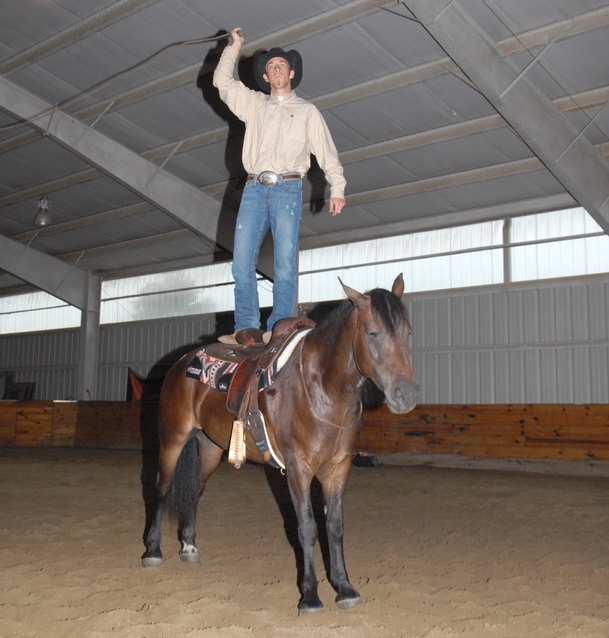
Scenario #2
An adult wild horse is taken to live on a large ranch, turned loose in a large field, with plenty of grass and a creek running through it. Every day a man goes out and check on the horse, sometimes walking very far out into the field to find it. The horse always runs from him, and he never chases it. He walks the fence line, checking it for holes or debris. The horse often watches him, but never gets close. Sometimes he goes out into the field and sits in the grass eating his lunch. Occasionally the horse creeps closer. The man pretends not to notice, but he always leaves his apple core behind, and once he leaves the field, the horse ventures over, smelling the scent he leaves behind. It finds the apple cores, and eats them. Eventually, when the mans appears, the horse will come closer. If he puts an apple down, and backs away, the horse will approach and eat the apple. When the snow comes, the man returns every day and breaks the ice on the creek to make sure the horse can drink. He scrapes snow away from the grass, and leaves hay in its place. The horse watches from the shelter of the trees.
Eventually, the horse doesn’t look at the man with suspicion when he comes to its field. Sometimes it follows him as he checks the fence. Sometimes it doesn’t bother to stop grazing. It knows the man won’t do anything to hurt it, because he’s never done anything to hurt it. It understands that he lives here, and it lives here. He likes apples, and it likes apples. It has no herd, but the man is sort of like a small herd. He does things a herd would do. He keeps the horse company, and the horse keeps him company.
One day while the man is checking the fence line, he falls down. He can’t stand up. Coyotes hear him yelling for help. The horse hears him, too. It goes to see what’s happening, and finds the coyotes circling it’s man. It’s herd. Rushing in defensively, the horse fights the coyotes, off, kicking them, and driving them away until they leave entirely. But the man still can’t get up. It’s getting dark, and very cold. The horse stays by the man, making sure that the coyotes don’t come back. Eventually, the man stops trying to move. The horse lies down close to him, and when he rolls up against it, the horse doesn’t move. It lies beside the man for hours, and then as the sun rises, other people appear in the field. There are lots of them, and they’re all yelling. The horse leaps up and runs away, then circles back to watch as the people finds its man and takes him away. The next day, its man returns hobbling on sticks, and he brings lots of apples with him.
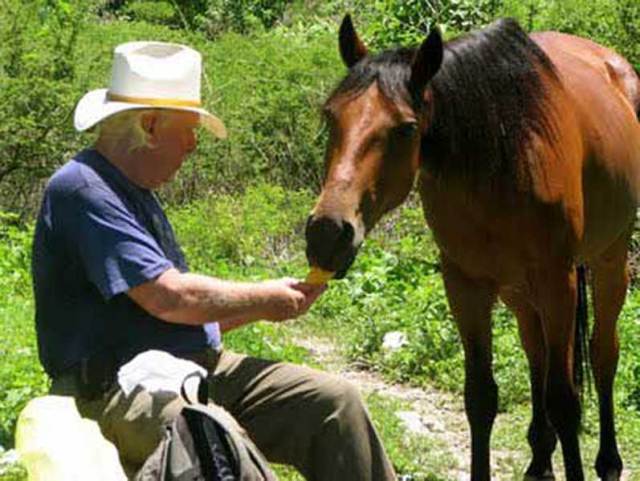
Now, if I were to ask you which one of the men in these scenarios had a spiritual bond with the horse, I have little doubt that you would say the man in #2. It seems obvious, doesn’t it? He’s asked nothing of the horse, and yet when he needs help the most, the horse guards him, and then keeps him warm until he’s rescued.
The baldly honest truth, though, is that a person might foster hundreds of wild horses in exactly the same manner, and no one of them would ever see him as part of the herd, not one of them would protect him from coyotes or lie beside him and keep him warm.
I’ve worked with horses–both domestic, and reclaimed mustangs–for almost thirty years, and there has been only one horse who did literally save and protect me. That’s what makes the special bond special. The fact that it is so rare. Only one horse out of hundreds that I’ve ridden, trained, helped be born, or cared for actually did save me. And in that situation, there was also a newborn foal involved, and the mare saved the foal, too, so that might well have been a situation wherein I was saved by coincidence, not intention.
And that’s okay. That doesn’t mean the horses I’ve cared for and raised didn’t love me.
The sort of spiritual connection that would cause a horse to view you as if you were another horse, is simply exceedingly rare. The sort of ritualistic connection that allows horses to interact with humans with respect and appreciation can be created through consistent, daily routine. That routine might involve depriving the horse of basic needs, so that it has no choice but to accept a relationship, or it might involve the longer process of learning to trust each other. But in either case, the bond is real, it’s just not exceptionally unique.
So, how does all of this relate to conservation and wild animals? It relates vitally if you look at celebrity conservationists like Eduardo Serio and his Black Jaguar White Tiger Foundation.
Serio has–as he so often boasts–has gathered almost five million followers on Instagram, and he didn’t do it by rescuing big cats. He did it by posting videos of himself playing with adolescent big cats, and other celebrities holding and coddling newborn big cat cubs.
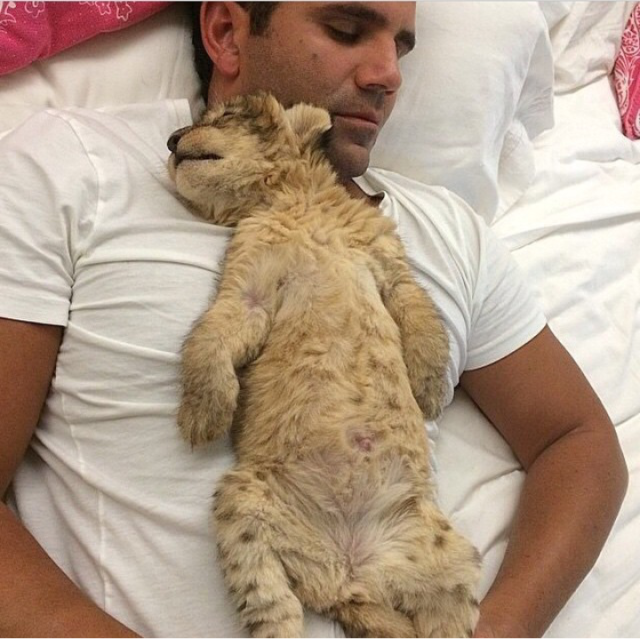
Some of Serio’s cats have supposedly come from circuses, but you never see him interacting with those cats because he can’t interact with them. He possesses no “special bond” with those cats because he has not hand-raised them from birth, has not systematically forced them to develop within the conformity of his own expectations. He does not have the bonds he has with his cats because he’s special, he has those bonds because he’s trained the cats to have them.
The dozens of newborn big cat cubs Serio constantly posts videos and photos of, are available to make those videos because they’re kept inside a house, locked in various rooms, and the only interactions they have with the outside world are interactions specifically relating to Serio or his staff. Those cubs–as Serio himself has admitted–are raised from shortly after birth, sometimes from before their eyes have even opened, living in Serio’s closet, sleeping in his bed, and being constantly handled by humans, indoctrinated into the ritual of human interaction. It is literally the only thing they know, the only thing they have ever been exposed to. When celebrity guests walk with the big cats in Serio’s possession, they are not being “brave” or “becoming part of the pride” they’re doing exactly what Serio and his staff have ritualistically done with the animals 24 hours a day, seven days a week since those animals were born. The animals don’t have a choice, they don’t even know they’re capable of refusing the contact.
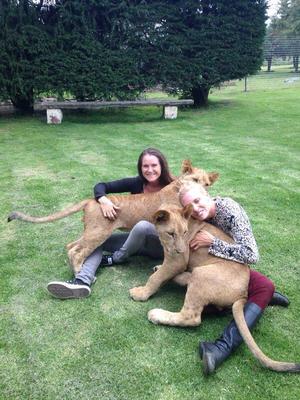
Serio vehemently denies “charging the public” to play with his animals. Instead, he offers them the chance to “sponsor” one of his ‘angels’ and with each level of sponsorship the donator receives certain benefits. Originally, and up until the recent spate of articles questioning the activities of Black Jaguar White Tiger, one of the benefits for those willing to donate $1,000.00 or more per month to his foundation, was a two day visit for two people to the Foundation–the location of which remains a closely guarded secret–and while there, handling and taking photos with the animals was part of the fun. Below is that donation page as seen in the ICARUS post titled Escaping the Matrix: Lifting the Veil on Black Jaguar White Tiger’s Pseudo Conservation of Big Cats.

Now, here is a current screenshot of BJWT’s sponsorship page. The benefit of a two day visit for two people to the Foundation has been suspiciously removed. Is this a response to the recent publicity regarding Serio’s allowance of handling? There’s no way to know. And since Serio refuses to ever admit any wrong doing at all, we’ll likely never know why the terms for $1,000.00 sponsorship were suddenly changed. Just as we’ll never know why he’s suddenly referring to BJWT as a “sanctuary” instead of “the Foundation” when they still are not a GFAS accredited sanctuary.

With, or without, the enticement to visit the Foundation in exchange for sponsorship, Serio continues to post videos and photos daily of both himself handling his cats, and of celebrity guests handling his cats. And regardless of any recent articles criticizing him, people seem to feel as if Serio is somehow ‘sharing his special bond’ with them by allowing them to participate. Serio’s 4 million+ followers on Instagram readily agree. Anyone who questions the validity of Serio’s ‘special bond’ with his ‘kids’ is cut down with verbal assaults and assertions, often which are nor more than the accusation that these ‘haters’ are simply “jealous” of Serio’s “special bond” because the aforementioned ‘haters’ will ‘never have that bond’.
What these followers fail to grasp is that anyone who purchases wild animals as babies, and keeps them isolated with only the owner to ritually care for them, will end up with baby big cats who excitedly run to them for comfort and affection.
These same blindly supportive fans also help to share numerous videos of interspecies “friendships” without grasping the fact that these “friendships” are nothing by contrived and forced pairings of animal interaction. Yes, it is possible for unexpected bonds to occur between species which otherwise might not interact, but rarely is a camera ever there to document the activity. Only a few times has such genuine and naturally occurring bonds happened, and often they last only a brief time. Videos of orangutans bottle feeding newborn big cat cubs are strictly the figment of one’s imagination. Namely the one creating and posting the video.
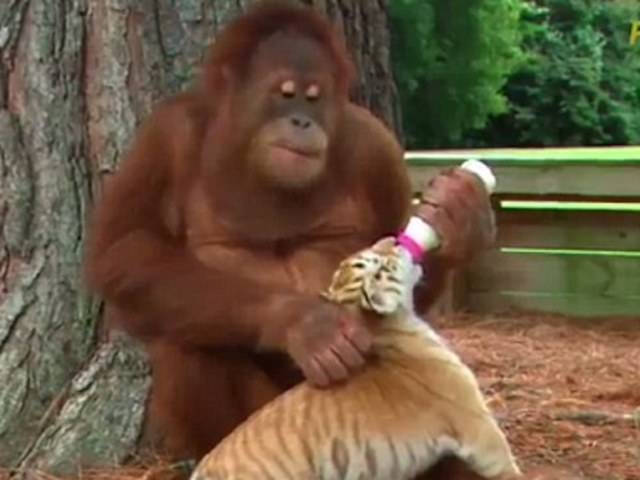
‘Doc’ Antle of T.I.G.E.R.S. is no better than Serio. In fact, Antle is a main source for many of those “unlikely friends” videos so often shared by Serio’s fans.
Antle continuously breeds–and inbreeds–big cats, bottle feeding the subsequent cubs, and hybrid cubs, using food and intimidation to impress show routines onto his cats. By the time they reach adulthood, the big cats are so ritualistically bent to a specific behavior pattern that feeding them milk from a baby bottle is their standard reward for doing as instructed. The public finds this an adorable way of giving the animals a treat, and fail to recognize it as the lynchpin in a systematic conditioning of behavior.
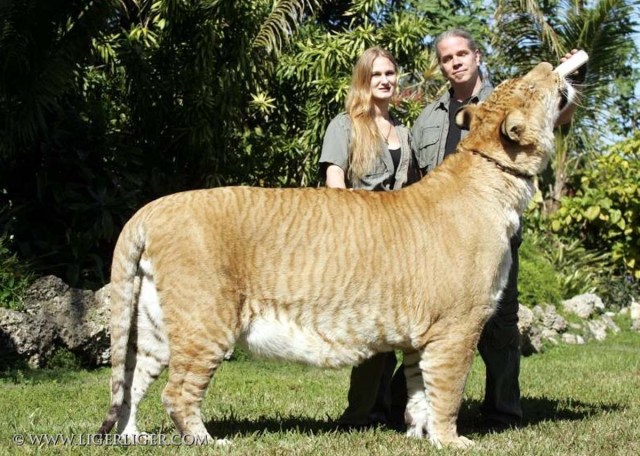
For Antle, the matter of cuddling his cubs is more a tourist draw, while the training of his animals takes center stage. The principal, however, is exactly the same. Antle prides himself on making the breeding and training of his cats an entire lifestyle. Prospective interns are expected to study Antle himself, and his methods, convert to veganism, they must be single, and change their entire mindset to match precisely how Antle says they should think. It is, much the same as Serio’s followers’ obsession with his “special bond”, simply a forced, and structured, ritualistic pattern of behavior, continually reinforced by how the animals are raised and maintained.
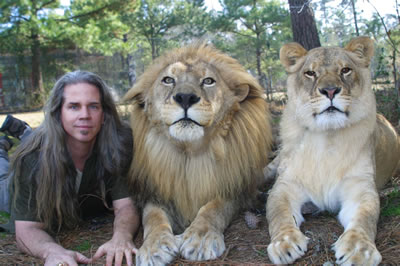
Similarly, Karl Mitchell has been breeding big cats for decades, regularly charging the public for the privilege of holding the subsequent offspring. Mitchell started out by training a house cat to ride a motorcycle. This is something that thousands of cat owners have done, but in Mitchell’s case, he believed that his success was a sign of his own innate ability to communicate with animals. He became a self-styled “animal guru” claiming to be able to train animals that no one else could, such as zebras and antelope. Eventually Mitchell moved on to big cats, which he insists are trained using ‘love’ as well as other methods he learned from his apprenticeships with various Hollywood animal trainers.
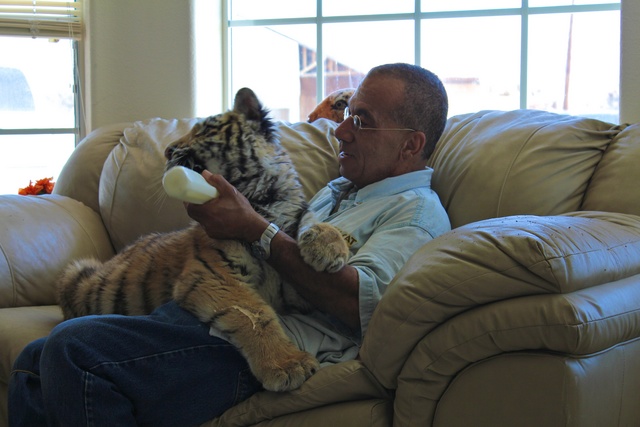 Because, apparently, feeding animals on your couch is how all the big time trainers do it.
Because, apparently, feeding animals on your couch is how all the big time trainers do it.
Mitchell’s property “The Ranch” has been the host to music videos, magazine shoots, and commercials. Mitchell maintains that he’s sought out by directors because of his ability to get animals to do what he wants, because of his guru-like skill with them. The truth is that Mitchell is a man constantly fighting allegations of animal abuse and mishandling, virtually all of them related to his big cats, and how they are treated.
He also uses The Ranch to allow high paying celebrities to play with his captive big cats.
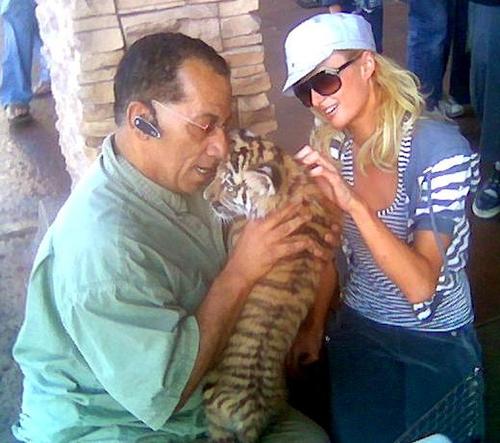 Paris Hilton just can’t seem to keep her hands off big cats, be it here in America with Karl, or down in Mexico at Black Jaguar White Tiger.
Paris Hilton just can’t seem to keep her hands off big cats, be it here in America with Karl, or down in Mexico at Black Jaguar White Tiger.
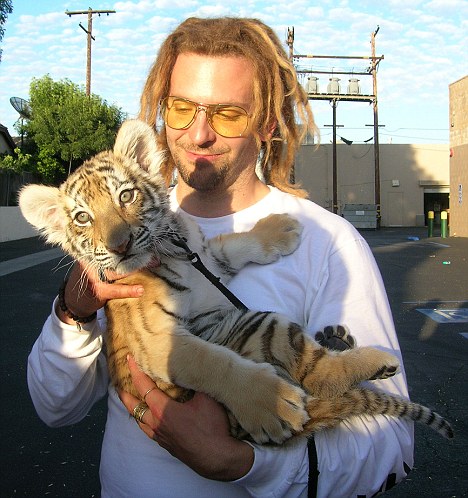
Serio, Antle, and Mitchell all claim to have special bonds with their animals. They all claim to be special snowflakes, different from every other person who keeps big cats as pets and allows others to play with them.
*Serio loudly proclaims that most of his ‘angels’ have been saved from circuses or other situations, despite that a huge number of his animals are far too young to have even been in a circus or possessed as pets. He refuses to spay or neuter his animals, and talks about repopulating the wild with his cats. Calls his foundation a “sanctuary” though it isn’t GFAS accredited.
*Antle insists that his breeding, and inbreeding of hybrid big cats, is necessary to the preservation of the species, and says that one day, he plans to reintroduce his cats to the wild. Also calls his businesses “sanctuaries” though neither are GFAS accredited.
*Mitchell insists that his final goal in breeding and maintaining big cats is to return them to the wild, and that he’s currently in contact with sanctuaries in India in regard to reintroducing tigers there.
All three of these men claim to have the exact same goals, the exact same bonds with their animals, and the exact same reasons for allowing the public to handle them. Everything they do, and all the money they make, they insist is for the animals.
They do it all, they say in the name of saving big cats and spreading awareness about the plights of wild big cats.
This is their mantra.
Yet while these proclamations come out of their mouths, their hands are busily handing off yet one more big cat cub to a waiting patron, eager to coddle the kitten and ‘share the special bond’ that its owner has so carefully created via ritualistic training.
By the time that kitten becomes an adult, no longer suitable for handling, another kitten will have been ‘rescued’ or otherwise secured, and will conveniently be available to help share the ‘special bond’ just like generations of assembly line victims of the special snowflake syndrome before it.
And yet millions of people all over the world continue to believe in the fairytale of special snowflakes. They continue to share Serio’s videos, and tout the ‘special bond’ he has with all of his ‘kids’. They continue to believe that people like Serio, Antle, and Mitchell should breed animals so that they can repopulate the wild spaces that currently can’t support the feeble populations of wild cats that still exist.
Until they open their eyes a recognize the ritualistic abuse for what it is, the cycle will continue.
Author: Artemis Grey
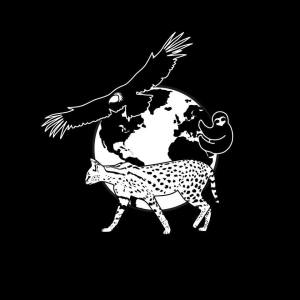

Very thought-provoking. When you write about “special snowflakes” from this angle, it reminds me of the Stockholm syndrome. This term describes the bond hostages often form with their captors. They can only do what their captors allow them to do, much like the cats possessed by the “heroes” you have described. And like these cats, many hostages develop child-like feelings of love for their captors.
Granted Serio has never threatened to kill his cats; which is a marked difference from hostage scenarios. Still, there is a chance that someone will be seriously injured while playing with one of his angels. When that happens the cat’s life will likely be forfeit.
LikeLike
Another spot-on! Great job, ICARUS! ❤
LikeLiked by 1 person
I worked for Doc Antle for eight years, and I can tell you that though the humans are not treated super well, not paid, not allowed to think for themselves, etc. we really did form special bonds with the cats. In the “about us” section of your site, two of you list having volunteered at CCF. When you google their founder, Laurie Marker, you see a ton of pictures of a lady snuggling cheetahs. Did she wander up to the wild cheetahs and slowly befriend them until they were willing to save her from hyenas? Or did she breed and hand raise them? Would you grant her the “special bond” certificate you deny Antle, because she has a more legitimate conservation platform in your opinion so it’s ok for her to do it but not him? I think you really have a problem with the conservation moniker these handlers bestow upon themselves, and less the fact that they have physical contact with the cats. Sure, the breeding that happens at these facilities is not really about directly conserving species. And they should be regulated and licensed all kinds of more effective ways. But these are not wild animals we are talking about, these are all captive born. A parakeet living in the wild is physically the same as a parakeet living as a beloved pet in someone’s house. A human living in an apartment in a city is physically the same a hunter gatherer living in some far flung rainforest. But there is still a difference, and that difference is experience. Neither of these animals is automatically living a miserable existence, it’s just not exactly the existence and specific environment the animal evolved to be in. It’s just a cultural romanticism of “wild” animals (which somehow includes tigers but not parakeets) that causes this vilification. Which leads people like Antle to cause their facilities to become more insular, requiring more of a code of silence and lying to the public in order to protect themselves. Which has, over the years, led to the facility becoming a cult. Really you don’t know what happens there, you are doing a lot of guessing. I do know, however. It’s not all good, but it’s not necessarily bad in the ways you are saying it is.
LikeLike
Hi Barbara,
I, personally, have not volunteered at CCF, and have no affiliation with them. Our founder admires CCF greatly for their incredible work in cheetah conservation. However, she does disagree with CCF on several issues surrounding handling, trophy hunting etc. That said, there are major differences between Antle and CCF. Antle breeds his animals-including inbreeding and hybrid breeding-for no reason beyond monetary gain. His animals, as you stated, are not wild, and are captive born, and can never be released. They exist solely to make money for Antle through his exploitation of them. While CCF may have, in the past, done things that the ICARUS team does not endorse, and is not attempting to justify in any way, they have, and continue to, participate in the rehabilitation of injured wild animals, and the subsequent reintroduction of those wild animals into their natural habitats. In addition, they actively work within the conservation community to change existing laws, and create new ones in the name of protecting animals in their wild habitats.
I will not presume to refute your own perception that you developed a ‘special bond’ with the animals you handled at Antle’s facility. I will, however, stand by my belief that as per your own description of the setting, those animals were raised from birth being subjected to the will and influence of the humans around them, and subesequently learned to function based off of human expectation. Therefore it is difficult for me to not see an affectionate working relationship, rather than a spontaneous spiritualistic bond, completely free of the influence of expectations, rewards, and discipline.
What we at ICARUS ‘have a problem with’ is both the physical contact these handlers have with their captive wild animals and their insistence that that handling is being done ‘in the name of conservation’. The handling of these animals is pure unadulterated exploitation, with the term ‘conservation’ tacked on in an attempt to justify that exploitation. We did not actually ever insinuate that the animals being exploited were ‘living in misery’. We asserted only that they were being exploited, and that those exploiting them claimed to be doing so in the name of conservation.
As far as ‘wild animals being physically the same as animals in captivity’ biologically speaking, you’re not entirely correct. After multiple generations in captivity, the very physiology of a species can, and does, change. This can present as susceptibility to disease that a wild animal of the same species remains resistant to, or it can be seen in more obvious physical changes. Aside from that, in the case of Antle, many of his animals have been intentionally inbred, or species which would not naturally ever breed have been intentionally bred specifically to create hybrids such as his ligers. Thus, your argument that the idea of ‘wild’ animals is nothing but a cultural romanticism designed to vilify breeders and exploiters is moot. There is no ‘wild’ version of Antle’s hybrids and inbred white tigers. The reason people such as Antle (or Serio) close their facilities is not because they’re being unjustly vilified, it’s because when put to the point, they cannot justify their actions as anything but exploitation.
I don’t need to go to facilities like Antle’s facility to understand that he is someone who breeds, crossbreeds, and exploits big cats, as well as other animals, in order to make money. Which is bad. Period.
Artemis
LikeLike
I can say I have experienced affectionate working relationships with animals at angles facility as well as strong “spiritual” bonds with a couple of animals. Sometimes things just click. I trained one particular tiger that I was very close to. There was no particular training regimen I followed with this cat, I was just in love with him and he was in love with me, and we just spent time together. We would walk and I would take him somewhere new, and just see if he wanted to, say, jump in the water or walk along a bench. And he didn’t do these things for a reward, I didn’t bait him or try and push him. He did them because he just thought of it as playing. He ended up being the best tiger cub Bhagavan had ever had up until that point. After that we tried to always have that same approach to all the cats, though by the time I left there were so many cubs it was hard to put in the hours that it takes to train that way. And Bhagavan makes money off the animals. That is true. The rest of the people there do not make any money. They don’t even get a day off. Zero days off a year, unless they have been there for a few years and want to go home for a couple days every few years. And the workday is from 8 am to 1 am for months at a time. They are utterly devoted to the comfort of their animals. Bhagavan doesn’t even really do it for money. He truly believes he is doing good. He lives in his own little world he has created and has some delusions he has cultivated about his own divinity, and he likes having control over that world. And he truly believes he is helping.
And as far as the inbreeding is concerned, all the tigers there have been bred in captivity for many generations. They do not act like cats born in the wild. They are slightly calmer and more accepting of human contact, though also gigantic and powerful so still dangerous. But less so. Remember, people have been breeding tigers in captivity for centuries at this point, so they aren’t quite the same as wild tigers anymore. Does that mean they shouldn’t exist? Maybe. Is it, or has it ever been ok to domesticate any animal? Maybe not. But I have a dog and a cat and I’m glad they exist. He does breed for colors, but I never saw him breed a cat to another cat that was a known relative. There was one cat he got in the beginning from a zoo that seemed to have some tooth problems when she got old, which was probably due to inbreeding, and her son who was a liger had the same problem in his old age. That is the only genetic flaw I observed from a cat born at the facility, and we are talking hundreds of cats. The white tigers born there were just as likely to come from an orange and black tiger as a white tiger. And he didn’t breed white tigers to white tigers. I also never saw a liger born at the facility. Sudan and Samson, the two that were there when I arrived, were apparently born there, then he got three from someone who I believe changed his mind on having them, if I remember correctly. He just recycled the story of how his first two came to be because he thought it sounded better. Now he has some I don’t know personally, which he might have bred, though I doubt he did because he didn’t have a lion that was bonded to tigers when I left.
At any rate, I’m trying to be totally honest with you. He is not really a super good person. But he is a super good tiger trainer. He shouldn’t have apes. He shouldn’t breed so many tiger cubs that go God knows where. But the tigers there are happy, or as happy as captive animals (like dogs and cats and parakeets and horses) can be.
LikeLike
Apologies for the delay in replying, Barbara,
Thank you for remaining civil in your interactions here. We appreciate calm interactions and the exchange of ideas, even contrasting ones. Again, I will make no assertion that you didn’t feel a bond with some of Antle’s cats, because I can’t say what you felt with them. I will, however, point out that you, yourself, in describing the cat with whom you felt a ‘spiritual’ bond described your initial communication as that of a trainer, by saying ‘I trained one particular tiger that I was very close to.’ The two of you might have been closely bonded, and perhaps you engaged in activities beyond the prescribed training regime. There was, however, a training regime, and that was the basis of your first interactions.
‘Breeding for color’ is, by definition in the big cat world, largely an act of inbreeding. White tigers are created by breeding carriers of recessive genes, thus creating a huge opportunity for defects and other developmental problems. In the case of the ligers, I have copied and pasted this passage verbatim from the T.I.G.E.R.S. website: ‘Ligers are not something we planned on having. We have lions and tigers living together in large enclosures. We had no idea how well one of the lion boys was getting along with a tiger girl. Low and behold, she had giant brown babies, and we knew we had ourselves some ligers.’ This shows, clearly that multiple animals of both sexes of breeding age were kept together intentionally. If Antle truly did not know that the animals would breed, it brings into question his understanding of big cats and their biology, and casts a shadow over his ‘expertise’ as anyone familiar with animals understands that uncut male horses will breed female zebras, or donkeys, etc. just as male big cats will breed any female big cat available to them. If Antle did know the cats would breed, well, then he did, in fact plan–or hope–to have ligers at his facility.
As far as your claim that these captive bred cats do not act like wild cats, and that they are not the same as wild cats, I would, gently, remind you that in previous comments, you asserted that captive big cats and wild big cats were exactly the same physically, and different only by the context of experience. Now, you are asserting that the generations of captive breeding has made the captive big cats calmer, and more accepting of human contact, something derived of a physical difference, not a learned on. You cannot have it both ways.
Antle might not be the worst person on the planet, but he does do what he does for money, if also for the prestige of being a ‘super good tiger trainer’ as you describe him. If Antle did not ‘get anything’ out of being famous for his cats, he would not consistently train them and put them on display and allow the public to handle them, all of which makes him ‘famous for his cats’.
The point, in the end, is that you are correct in your statement that Antle is not a ‘really super good person’. As far as the ICARUS group is concerned, he’s not a conservationist, either. No matter how much he claims to be one.
LikeLike
Another great article. Keep up the great work, Serio will one day come apart. It is just a matter of time. I must also state here that one of his most die hard followers loves to issue death threats. That’s how insane she is. It is interesting to note that most of his followers cannot back up their opinions of him with educational or scientific data. Their usual rhetoric includes name calling and abuse. The one I mentioned above called me an old cronie and pointed out he has 5 million followers as opposed to my piddly few. Wow…. The new measuring stick for conservation!!!!! We must all keep a close eye on Serio. He will slip. And I, for one, cannot wait.
LikeLike
Pingback: Dying For The Perfect Photo: The Selfies With Animals Epidemic – Project ICARUS